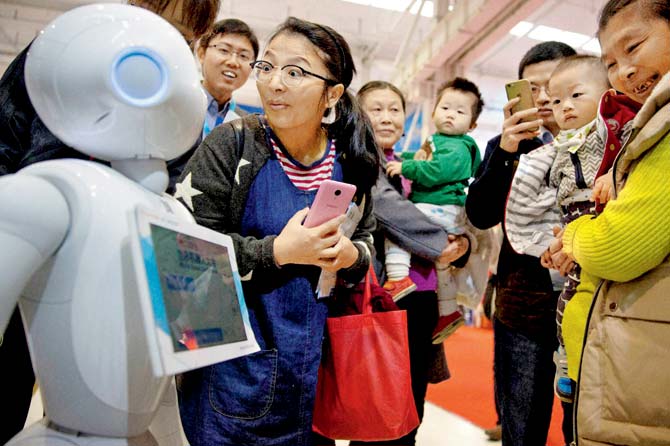Almost all developing countries across the globe seek technology for national development. But China has turned it into a fine art

 Visitors take a closer look at Pepper, a companion robot, at the World Robot Conference in China, which is now focused on high-end technology. Pic/AP
Visitors take a closer look at Pepper, a companion robot, at the World Robot Conference in China, which is now focused on high-end technology. Pic/AP
 Chinese economic developments are of great interest to everyone. Whether it is growing fast, or undergoing a slowdown, it impacts the world economy like no other. China has declared its intention of moving its economy from one based on investment and exports, to one relying on consumption. They have made it clear that in the coming years, China will occupy a higher and higher position in global value chains and become, like the US, Europe or Japan, a producer of high-end components. The process is now underway and is being watched with great interest because it has implications for the entire global economy.
Chinese economic developments are of great interest to everyone. Whether it is growing fast, or undergoing a slowdown, it impacts the world economy like no other. China has declared its intention of moving its economy from one based on investment and exports, to one relying on consumption. They have made it clear that in the coming years, China will occupy a higher and higher position in global value chains and become, like the US, Europe or Japan, a producer of high-end components. The process is now underway and is being watched with great interest because it has implications for the entire global economy.
Beyond the macro picture, there are smaller signs of structural shifts and new trends in the Chinese economy. In the past, China was often an element in the supply chain, where higher value and high-tech items came from other suppliers, say, Germany, Taiwan or Japan. The famous case was that of the iPhone 6 which retailed for $600 in the US in 2012, of which Apple made $250, the Japanese makers of the touch systems and screens made $70 and smaller amounts were made by the Korean and Taiwanese suppliers of the batteries, flash memory, cameras etc. The Chinese made just about $8, mainly in terms of labour cost, to assemble it. But the Chinese are determined to move up in the value chain. The government is working systematically to build high-end capabilities and intends to raise the domestic content of core components and key materials to 40 per cent by 2020 and 70 per cent by 2025. This goes along with higher R&D expenditures of some $213 billion in 2015, equivalent to 2.1 per cent of the GDP.
One indicator of this are the Chinese acquisitions in high-tech industries in Europe and the US, which have accelerated in the past year. This July, Zhongwang, a state supported enterprise, bought Aleris, a US company specialising in making rolled aluminium products for aerospace and automotive industries. Earlier this year, Kuka, a German company specialising in making robots for automobile plants, was bought by Midea Group — China’s largest home appliance maker.
More recently, Aixtron, a German company with a long history of making advanced tools required for making sophisticated semiconductors, was bought by the Chinese. The Aixtron case could well point to the problem. Last year, the German company’s share prices tumbled when a Chinese buyer San’an Optronics cancelled a large order at the last minute. As a result, the company went up for sale and a Chinese investment group, Fujian Grand Chip offered to buy it in May, this year. Mercator Institute of Chinese Studies, which tracked the issue, found that San’an and Fujian had a common principal investor in Liu Zhendong. Further, there was a great deal of funding through local and national investment funds for both companies from the Chinese government that has set aside funds to encourage a Chinese semiconductor industry.
China has an eye on US firms too, though the latter keeps a more wary eye on them through the Committee on Foreign Investment in the US (CIFUS) which has shot down big-ticket investments like the one for Fairchild Semiconductors. Likewise, Beijing’s Unisplendour Corp withdrew from a deal to buy a stake in Western Digital due to regulatory pressure.
One major area to watch is the field of Artificial Intelligence (AI). A White House assessment of AI research indicates that today China with 350 publications leads the field with the US at number two, with a little over 250. All other players — UK, Australia, Canada, Japan, Germany, Singapore, South Korea or France — produce a little above 50 or a little less than that. This is not just an absolute lead — looked at through their citations by other scholars (a measure of their influence) indicates China remains number one. Baidu, China’s equivalent of Google, runs a huge centre for AI research in San Jose, where its chief scientist, Andrew Ng is also an associate professor at the Stanford University’s computer science department. This centre employs some of the topmost American AI researchers.
All developing countries want technology for national development. But China has made it into a fine art. Reverse-engineered Soviet technology kept China going till 1990s. Thereafter, as it opened up, China made strategic acquisitions in areas like railways, power, aerospace and automotives with a view to establish its own industries. In this drive, China has not hesitated to undertake industrial espionage and cyber-theft. Then, using opaque rules and regulations, the Chinese have systematically encouraged their champions and fobbed off the western companies and in many instances now, they have emerged as their competitors — railways and nuclear power reactors are two prominent examples.
But this is only the beginning, China has now taken aim in a range of high-end fields like AI, robotics, aerospace, renewable energy, pharmaceuticals and biotechnology and intends to be the world leader in all of them by the time of their twin centenary — 2049, the anniversary of the revolution.
The writer is a Distinguished Fellow, Observer Research Foundation, New Delhi. Send your feedback to mailbag@mid-day.com
 Subscribe today by clicking the link and stay updated with the latest news!" Click here!
Subscribe today by clicking the link and stay updated with the latest news!" Click here!









